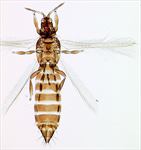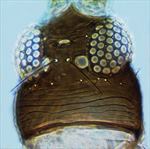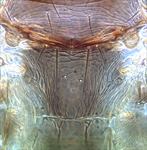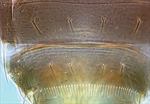
Female

Antenna

Head

Pronotum

Meso & metanota

Fore tarsus with apical claw

Thoracic sternites

Tergites VII-VIII

Female sternite VII

Fore wing
Both sexes fully winged. Body brown, with yellowish brown tarsi and antennal segment III; fore wings light brown, base pale but extreme apex darker. Antennae 8-segmented; segments III & IV with sense cone forked. Head longer than wide, projecting slightly in front of eyes; without sculpture between ocelli; two pairs of ocellar setae present, pair III as long as distance between compound eyes, arising between hind ocelli. Pronotum with few discal setae, 2 pairs of long posteroangular setae; posterior margin with one pair of small setae laterally, also one pair of prominent setae medially arising in front of margin. Fore tarsal pulvillus with recurved claw at apex. Metanotum weakly reticulate; median setae at anterior margin; campaniform sensilla present. Fore wing first vein with 2–4 setae on distal half; second vein with complete row of about 14 setae. Abdominal tergites with no sculpture medially; tergites VI–VIII with median setae at least half length of tergite; tergite VIII with posteromarginal comb of long regular microtrichia. Sternites without discal setae, VII with only setal pair S1 arising in front of margin.
Male smaller than female; sternites V–VII with small pore plate medially.
There are 30 species listed in the genus Taeniothrips, together with a further 21 that are known only from fossils. Three species are European in origin, one is from western North America, and the rest are from Asia. The western North American species, T. orionis, is particularly similar to T. major Bagnall from the Himalayan region of northern India and Pakistan. In the European species T. picipes antennal III is considerably paler, and T. inconsequens has a terminal claw on the fore tarsus, and the metanotal median setae further apart.
Commonly known as the Pear Thrips, this species breeds on young leaves before these are fully expanded (Teulon et al., 1994). Adults have been recorded from over 200 plant species, with breeding records from 34 tree species including species of Acer [Aceraceae], Fagus and Quercus [Fagaceae], Fraxinus [Oleaceae], Prunus and Pyrus [Rosaceae] (Teulon et al., 1994). This thrips can seriously damage young leaves and cause premature leaf fall of sugar maple in north eastern USA, although it was previously known as a pest of pear trees in California.
Originally from Europe, this thrips is widespread across the Northern Hemisphere, from Sweden to Japan and Korea. It is presumably introduced to California, the northern States of the USA, and Canada.
THRIPIDAE - THRIPINAE
Taeniothrips inconsequens (Uzel)
Physopus inconsequens Uzel, 1895: 117
Euthrips pyri Daniel, 1904: 294
Physothrips calcaratus Bagnall, 1916: 221.
Mound LA, Azidah AA & Ng YF (2012) Key to the non-fossil species of the genus Taeniothrips (Thysanoptera, Thripidae). Zootaxa 3414: 33–42.
Teulon DAJ, Groninger JW & Cameron EA (1994) Distribution and host plant associations of Taeniothrips inconsequens (Thysanoptera: Thripidae). Environmental Entomology 23: 587–611.